KitchenAid KSBP23INSS01, KSBP25INSS01, KSBS23INBL01, KSBS23INBT01, KSBS23INWH01 User Manual
...
REFRIGERATOR USER INSTRUCTIONS
THANK YOU for purchasing this high-quality product. If you should experience a problem not covered in TROUBLESHOOTING, please visit our website at www.kitchenaid.com for additional information. If you still need assistance, call us at 1-800-422-1230. In Canada, visit our website at www.kitchenaid.ca or call us at 1-800-807-6777.
You will need your model and serial number located on the right-hand side of the refrigerator interior.
Para obtener acceso a “Instrucciones para el usuario del refrigerador” en español, o para obtener información adicional acerca de su producto, visite: www.kitchenaid.com.
Tenga listo su número de modelo completo. Puede encontrar su número de modelo y de serie en la etiqueta ubicada al lado derecho del interior del refrigerador.
Tableof Contents/Tabledesmatières
REFRIGERATOR SAFETY....................................................... |
1 |
REFRIGERATOR USE.............................................................. |
2 |
REFRIGERATOR CARE........................................................... |
6 |
TROUBLESHOOTING.............................................................. |
7 |
ACCESSORIES......................................................................... |
9 |
WATER FILTER CERTIFICATIONS ........................................ |
9 |
PERFORMANCE DATA SHEETS.......................................... |
10 |
WARRANTY............................................................................ |
11 |
SÉCURITÉ DU RÉFRIGÉRATEUR....................................... |
12 |
UTILISATION DU RÉFRIGÉRATEUR .................................. |
13 |
ENTRETIEN DU RÉFRIGÉRATEUR..................................... |
17 |
DÉPANNAGE ......................................................................... |
18 |
ACCESSOIRES...................................................................... |
21 |
FEUILLES DE DONNÉES SUR LA PERFORMANCE ......... |
22 |
GARANTIE ............................................................................. |
23 |
REFRIGERATOR SAFETY
Your safety and the safety of others are very important.
We have provided many important safety messages in this manual and on your appliance. Always read and obey all safety messages.
This is the safety alert symbol.
This symbol alerts you to potential hazards that can kill or hurt you and others.
All safety messages will follow the safety alert symbol and either the word “DANGER” or “WARNING.” These words mean:
 DANGER
DANGER
 WARNING
WARNING
You can be killed or seriously injured if you don't immediately follow instructions.
You can be killed or seriously injured if you don't follow instructions.
All safety messages will tell you what the potential hazard is, tell you how to reduce the chance of injury, and tell you what can happen if the instructions are not followed.
W10162434A
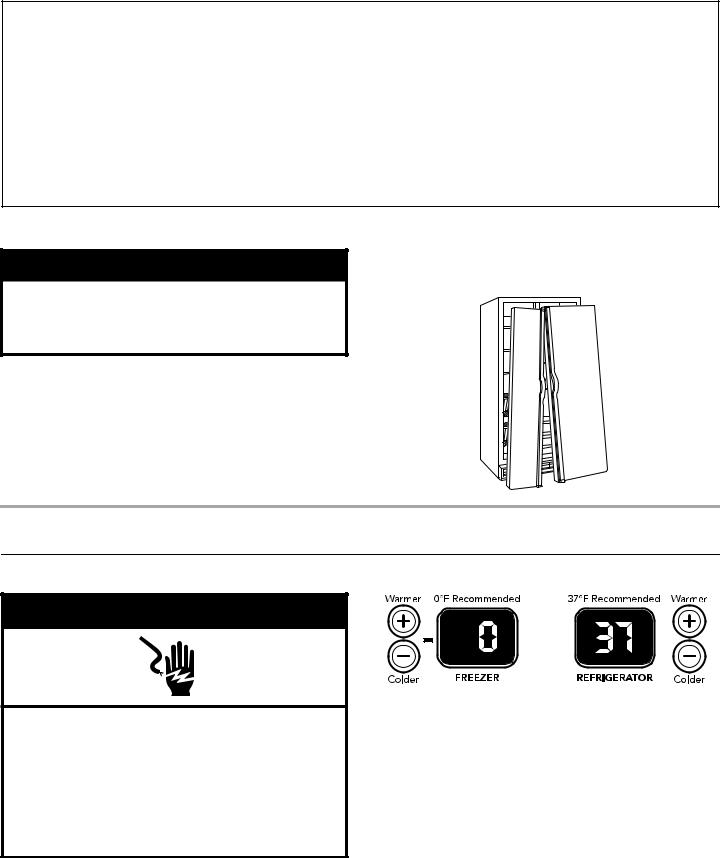
IMPORTANT SAFETY INSTRUCTIONS
WARNING: To reduce the risk of fire, electric shock, or injury when using your refrigerator, follow these basic precautions:
■ Use nonflammable cleaner.
■ Keep flammable materials and vapors, such as gasoline, away from refrigerator.
■ Use two or more people to move and install refrigerator.
■ Disconnect power before installing ice maker (on ice maker kit ready models only).
■ Use a sturdy glass when dispensing ice (on some models).
SAVE THESE INSTRUCTIONS
Proper Disposal ofYour Old Refrigerator
Before You Throw Away Your Old Refrigerator or Freezer:
■Take off the doors.
 WARNING
WARNING
Suffocation Hazard
Remove doors from your old refrigerator.
Failure to do so can result in death or brain damage.
IMPORTANT: Child entrapment and suffocation are not problems of the past. Junked or abandoned refrigerators are still dangerous
– even if they will sit for “just a few days.” If you are getting rid of your old refrigerator, please follow these instructions to help prevent accidents.
■Leave the shelves in place so that children may not easily climb inside.
REFRIGERATOR USE
UsingtheControls
 WARNING
WARNING
Electrical Shock Hazard
Plug into a grounded 3 prong outlet.
Do not remove ground prong.
Do not use an adapter.
Do not use an extension cord.
Failure to follow these instructions can result in death, fire, or electrical shock.
NOTE: Make sure the refrigerator is plugged into a grounded 3 prong outlet.
For your convenience, your refrigerator controls are preset at the factory. When you first install your refrigerator, make sure that the controls are still preset to the mid-settings as shown.
IMPORTANT:
■The refrigerator control adjusts the refrigerator compartment temperature. The freezer control adjusts the freezer compartment temperature.
■The displays normally show the actual temperatures inside the refrigerator and freezer compartments. Sometimes, temperatures may vary slightly in different areas of each compartment. For example, frequently opening the door allows air from the room to enter the compartment, exposing door bins to room-temperature air. When reading the display, keep in mind that it shows an average temperature for the entire compartment. If you want to view the temperature you set for the compartment rather than the actual temperature, see “Viewing Set Points.”
2
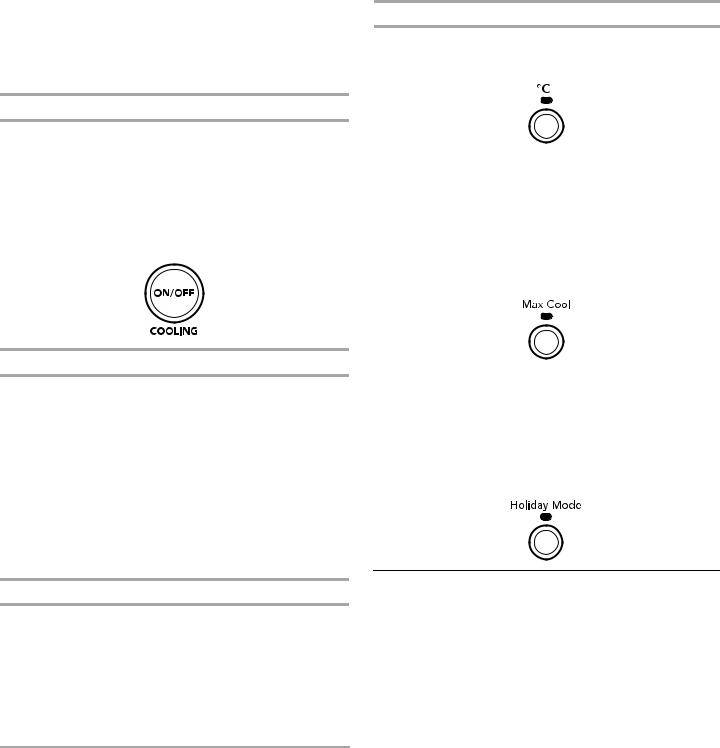
■Wait 24 hours before you put food into the refrigerator. If you add food before the refrigerator has cooled completely, your food may spoil.
NOTE: Adjusting the refrigerator and freezer controls to a lower (colder) setting will not cool the compartments any faster.
Turning Refrigerator On
■If the refrigerator is off, press COOLING ON/OFF to turn the cooling on.
■To turn your refrigerator off, press COOLING ON/OFF. Your refrigerator will not cool when the control is set to Off.
NOTE: Pressing the Cooling On/Off button does not disconnect power to the refrigerator. The interior lights will turn off if either compartment door is open for more than 10 minutes. Simply close and open the door to turn on the interior lights.
Viewing Set Points
The factory recommended set points are 0°F (-18°C) for the freezer and 37°F (3°C) for the refrigerator.
Set point range for the freezer: -6° to 6°F (-21°C to -14°C) Set point range for the refrigerator: 32° to 46°F (0°C to 8°C)
To view the set point temperatures, press either the up or down button for the refrigerator or freezer temperature. The display will become brighter to indicate that you are viewing the set points. Five seconds after an adjustment is made, the display lights will dim and return to the actual temperature.
NOTE: During automatic defrost cycles, the actual temperature displayed may be higher than the set point. This is normal. The actual temperatures should return to the set points within a few hours following completion of the defrost cycle.
Adjusting Controls
The mid-settings indicated in the previous section should be correct for normal household refrigerator usage. The controls are set correctly when milk or juice is as cold as you like and when ice cream is firm.
If the temperature is too warm or too cold in the refrigerator or freezer, first check the air vents to be sure they are not blocked.
If you need to adjust temperatures, use the settings listed in the chart below as a guide. Wait at least 24 hours between adjustments.
CONDITION/REASON: |
ADJUSTMENT: |
|
|
REFRIGERATOR too warm |
REFRIGERATOR |
|
Control 1° lower |
|
|
FREEZER too warm/too little ice |
FREEZER Control 1° |
|
lower |
|
|
REFRIGERATOR too cold |
REFRIGERATOR |
|
Control 1° higher |
|
|
FREEZER too cold |
FREEZER Control 1° |
|
higher |
|
|
Additional Control Panel Features
Temp Mode
■Press the °C button to select either Celsius or Fahrenheit temperature displays.
Max Cool
Use Max Cool to speed cooling when large grocery loads are added. Max Cool sets the refrigerator temperature to 34°F (1°C) and the freezer temperature to -6°F (-21°C) for 24 hours.
NOTE: While Max Cool is on, the display shows the Max Cool temperature set points. After 24 hours or when Max Cool is manually turned off, the set points will be returned to their previous setting.
■Press MAX COOL to select this mode. Max Cool will stay on for 24 hours or until it is manually turned off.
Holiday Mode
Holiday Mode is designed for the traveler who wishes to save additional energy or for those whose religious observances require turning off the lights and ice maker. In Holiday Mode, the temperature set points remain unchanged, the ice maker and dispenser levers are disabled, and the interior lights turn off.
■Press HOLIDAY MODE to turn on the Holiday Mode feature. This feature will remain on until the Holiday Mode key is pressed again.
ConvertibleDrawerTemperatureControl
The control can be adjusted to properly chill meats or vegetables. The air inside the pan is cooled to avoid “spot” freezing and can be set to keep meats at the National Livestock and Meat Board recommended storage temperatures of 28° to 32°F (-2° to 0°C). The convertible drawer temperature control is preset to the PRODUCE setting.
To Store Meat:
Set the control to one of the three MEAT settings to store meat at its optimal storage temperature.
To Store Vegetables:
Set the control to PRODUCE to store vegetables at their optimal storage temperatures.
NOTE: If food starts to freeze, move the control to the left (less cold). Remember to wait 24 hours between adjustments.
3
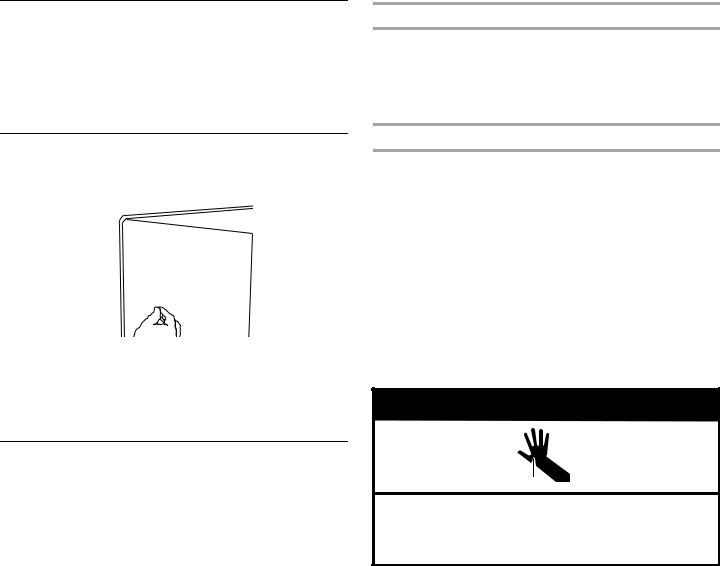
CrisperHumidityControl
(onsomemodels)
You can control the amount of humidity in the moisture-sealed crisper. Adjust the control to any setting between LOW and HIGH.
LOW (open) for best storage of fruits and vegetables with skins.
HIGH (closed) for best storage of fresh, leafy vegetables.
DoorAirControl
The door air control is located on the left-hand side of the refrigerator compartment.
A 

A.Door air control
■Slide the door air control to the left to reduce the flow of cold air to the bin or can rack and make it less cold.
■Slide the door air control to the right to increase the flow of cold air to the bin or can rack and make it colder.
WaterandIceDispensers
(onsomemodels)
Depending on your model, you may have one or more of the following options: the ability to select either crushed or cubed ice, a special light that turns on when you use the dispenser, or a lock option to avoid unintentional dispensing.
NOTES:
■The dispensing system will not operate when the freezer door is open.
■After connecting the refrigerator to a water source, flush the water system. Use a sturdy container to depress and hold the water dispenser lever for 5 seconds, then release it for
5 seconds. Repeat until water begins to flow. Once water begins to flow, continue depressing and releasing the dispenser lever (5 seconds on, 5 seconds off) for an additional 2 minutes. This will flush air from the filter and water dispensing system. Additional flushing may be required in some households. As air is cleared from the system, water may spurt out of the dispenser.
■Allow 24 hours for the refrigerator to cool down and chill water.
■Allow 24 hours to produce the first batch of ice. Discard the first three batches of ice produced.
The Water Dispenser
IMPORTANT: Dispense enough water every week to maintain a fresh supply.
To Dispense Water:
1.Press a sturdy glass against the water dispenser lever.
2.Remove the glass to stop dispensing.
The Ice Dispenser
The dispensing system will not operate when the freezer door is open. Ice dispenses from the ice maker storage bin in the freezer when the dispenser lever is pressed.
NOTE: Some models dispense both cubed and crushed ice. Before dispensing ice, select which type of ice you prefer.
For crushed ice, cubes are crushed before being dispensed. This may cause a slight delay when dispensing crushed ice. Noise from the ice crusher is normal, and pieces of ice may vary in size. When changing from crushed to cubed, a few ounces of crushed ice will be dispensed along with the first cubes.
To Dispense Ice:
1.If the ice storage bin is located on the door, remove the temporary shield from underneath the ice storage bin. See “Ice Maker and Storage Bin.”
2.Press the button to select the desired type of ice.
 WARNING
WARNING
Cut Hazard
Use a sturdy glass when dispensing ice.
Failure to do so can result in cuts.
3.Press a sturdy glass against the ice dispenser lever. Hold the glass close to the dispenser opening so ice does not fall outside of the glass.
IMPORTANT: You do not need to apply a lot of pressure to the lever in order to activate the ice dispenser. Pressing hard will not make the ice dispense faster or in greater quantities.
4.Remove the glass to stop dispensing.
4
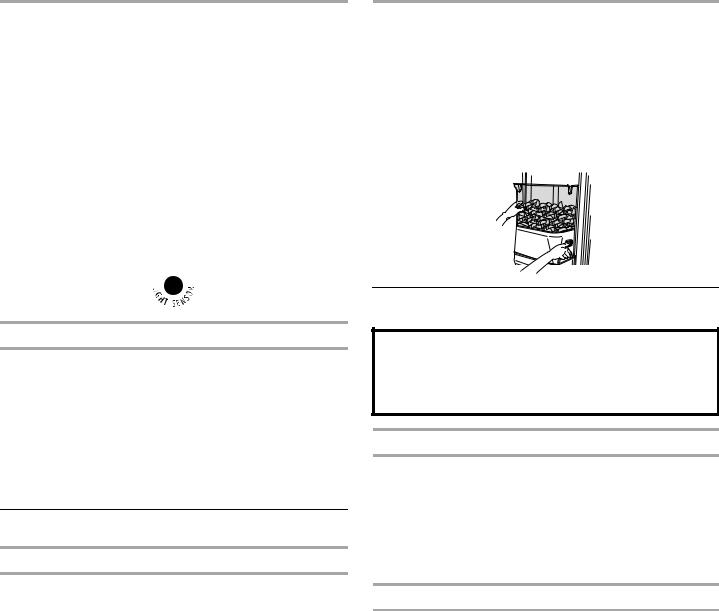
The Dispenser Light |
|
Removing and Replacing Ice Storage Bin |
Style 1: The dispenser light can be turned on by pressing the ON button.
Style 2: When you use the dispenser, the lever will automatically turn the light on. If you want the light to be on continuously, you may choose either ON or NIGHT LIGHT.
ON: Press the LIGHT button to turn on the dispenser light.
NIGHT LIGHT: Press the LIGHT button a second time to select the Night Light. The dispenser light will automatically adjust to become brighter as the room brightens, dimmer as the room darkens.
OFF: Press the LIGHT button a third time to turn off the dispenser light.
The dispenser lights are LEDs which should not need to be changed. If it appears that your dispenser lights are not working, be sure that the light sensor is not blocked (in Night Light mode). See “Troubleshooting” for more information.
The Dispenser Lock (on some models)
The dispenser can be turned off for easy cleaning or to avoid unintentional dispensing by small children and pets.
NOTE: The lock feature does not shut off power to the product, to the ice maker, or to the dispenser light. It simply deactivates the dispenser levers. The ice and water dispensers will not work.
Style 1: Press the LOCK button to lock the dispenser. Press the UNLOCK button to unlock the dispenser.
Style 2: Press and hold the LOCK OUT button to lock the dispenser. Press and hold the LOCK OUT button a second time to unlock the dispenser.
IceMakerandStorageBin
Turning the Ice Maker On/Off
The On/Off switch is located on the top right-hand side of the freezer compartment.
To turn on the ice maker, slide the control to the ON (left) position.
To manually turn off the ice maker, slide the control to the OFF (right) position.
NOTE: Your ice maker has an automatic shutoff. The ice maker sensors will automatically stop ice production, but the control will remain in the ON (left) position.
REMEMBER:
■Allow 24 hours to produce the first batch of ice. Discard the first three batches of ice produced.
■The quality of your ice will be only as good as the quality of the water supplied to your ice maker. Avoid connecting the ice maker to a softened water supply. Water softener chemicals (such as salt) can damage parts of the ice maker and lead to poor quality ice. If a softened water supply cannot be avoided, make sure the water softener is operating properly and is well maintained.
■Do not use anything sharp to break up the ice in the storage bin. This can cause damage to the ice container and the dispenser mechanism.
■Do not store anything on top of or in the ice maker or storage bin.
1.Hold the base of the storage bin with both hands and press the release button to lift the storage bin up and out.
NOTE: It is not necessary to turn the ice maker control to the OFF (right) position when removing the storage bin. The sensor cover (“flipper door”) on the left wall of the freezer stops the ice maker from producing ice if the door is open or the storage bin is removed.
2.Replace the storage bin on the door and push down to make sure it is securely in place.
WaterFiltrationSystem
Do not use with water that is microbiologically unsafe or of unknown quality without adequate disinfection before or after the system. Systems certified for cyst reduction may be used on disinfected waters that may contain filterable cysts.
Water Filter Status Display (on some models)
The filter status display will help you know when to change your water filter. When the display reads 10%, order a new filter. It is recommended that you replace the filter when the display reads 0% OR when water flow to your water dispenser or ice maker decreases noticeably. The filter should be replaced at least every 6 months depending on your water quality and usage.
After changing the filter, reset the display by pressing the button. The display will read 99% when the system is reset.
Non-Indicator Water Filter (on some models)
If your refrigerator does not have the water filter status light, you should change the water filter cartridge at least every 6 months depending on your water quality and usage. If the water flow to the water dispenser or ice maker decreases noticeably before
6 months have passed, replace the water filter more often.
5

Changing the Water Filter
1.Press the eject button to release the filter from the base grille.
2.Pull the filter straight out.
3.Turn the cap counterclockwise to remove it from the filter.
IMPORTANT: Do not discard the cap. It is part of your refrigerator. Keep the cap to use with the replacement filter.
4.Align the ridge on the cap with the arrow on the new filter and turn the cap until it snaps into place.
NOTE: You can run the dispenser without a filter. Your water will not be filtered. Simply insert the cap all of the way into the base grille and rotate the cap until it is firmly in place.
5.Remove the protective covers from the O-rings. Be sure the O-rings are still in place after the covers are removed.
6.Push the filter into the base grille. The eject button will pop back out when the filter is fully engaged.
7.Flush the water system. See “Water and Ice Dispensers.”
REFRIGERATOR CARE
Cleaning
 WARNING
WARNING
Explosion Hazard
Use nonflammable cleaner.
Failure to do so can result in death, explosion, or fire.
Both the refrigerator and freezer sections defrost automatically. However, clean both sections about once a month to avoid buildup of odors. Wipe up spills immediately.
IMPORTANT: Because air circulates between both sections, any odors formed in one section will transfer to the other. You must thoroughly clean both sections to eliminate odors. To avoid odor transfer and drying out of food, wrap or cover foods tightly.
To Clean Your Refrigerator:
NOTE: Do not use abrasive or harsh cleaners such as window sprays, scouring cleansers, flammable fluids, cleaning waxes, concentrated detergents, bleaches or cleansers containing petroleum products on plastic parts, interior and door liners or gaskets. Do not use paper towels, scouring pads, or other harsh cleaning tools.
1.Unplug refrigerator or disconnect power.
2.Hand wash, rinse, and dry removable parts and interior surfaces thoroughly. Use a clean sponge or soft cloth and a mild detergent in warm water.
3.Wash stainless steel and painted metal exteriors with a clean sponge or soft cloth and a mild detergent in warm water.
4.There is no need for routine condenser cleaning in normal home operating environments. If the environment is particularly greasy or dusty, or there is significant pet traffic in the home, the condenser should be cleaned every 2 to
3 months to ensure maximum efficiency. If you need to clean the condenser:
■Remove the base grille.
■Use a vacuum cleaner with a soft brush to clean the grille, the open areas behind the grille and the front surface area of the condenser.
■Replace the base grille when finished.
5.Plug in refrigerator or reconnect power.
ChangingtheLightBulbs
NOTE: Not all bulbs will fit your refrigerator. Be sure to replace the bulb with one of the same size, shape and wattage. On some models, the dispenser light requires a heavy duty 10-watt bulb. All other lights require a 40-watt bulb. Replacement bulbs are available from your dealer.
1.Unplug refrigerator or disconnect power.
2.Remove light shield when applicable.
NOTE: To clean the light shield, wash it with warm water and liquid detergent. Rinse and dry the shield well.
3.Remove light bulb and replace with one of the same size, shape and wattage.
4.Replace light shield when applicable.
5.Plug in refrigerator or reconnect power.
6
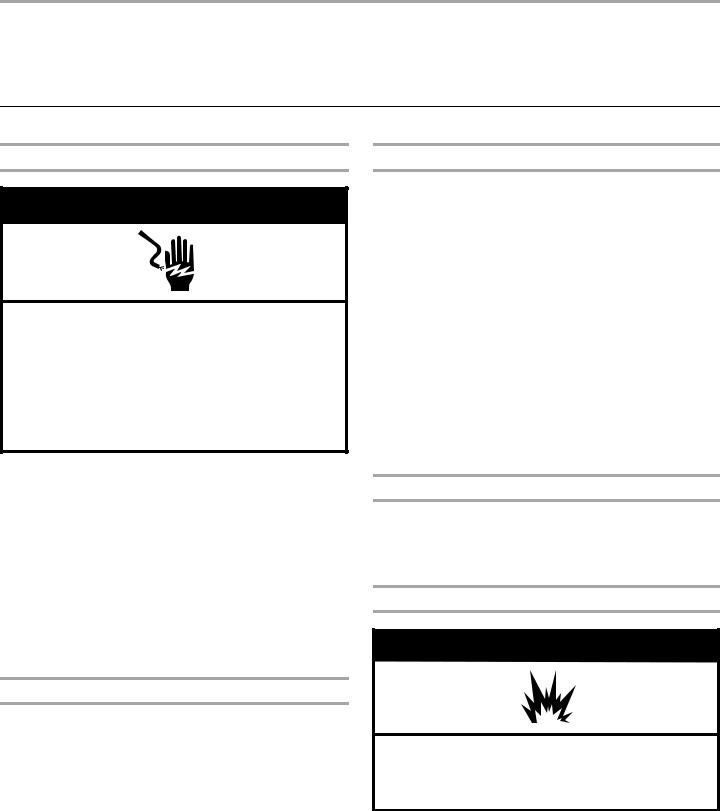
TROUBLESHOOTING
First try the solutions suggested here or visit our website and reference FAQs (Frequently Asked Questions) to possibly avoid the cost of a service call.
In the U.S.A., www.kitchenaid.com In Canada, www.kitchenaid.ca
RefrigeratorOperation
The refrigerator will not operate
 WARNING
WARNING
Electrical Shock Hazard
Plug into a grounded 3 prong outlet.
Do not remove ground prong.
Do not use an adapter.
Do not use an extension cord.
Failure to follow these instructions can result in death, fire, or electrical shock.
■Power cord unplugged? Plug into a grounded 3 prong outlet.
■Is outlet working? Plug in a lamp to see if the outlet is working.
■Household fuse blown or circuit breaker tripped? Replace the fuse or reset the circuit breaker. If the problem continues, call an electrician.
■Are controls on? Make sure the refrigerator controls are on. See “Using the Controls.”
■New installation? Allow 24 hours following installation for the refrigerator to cool completely.
NOTE: Adjusting the temperature controls to coldest setting will not cool either compartment more quickly.
The motor seems to run too much
Your new refrigerator may run longer than your old one due to its high-efficiency compressor and fans. To maximize energy efficiency, the compressor changes speed to provide just the right amount of cooling as it is needed. Your refrigerator may run as much as 100% of the time, but it will still use less energy than an older refrigerator. You may notice that it runs more often when the room is warm, a large amount of food is added to either compartment, or the doors are opened often.
The refrigerator is noisy
Refrigerator noise has been reduced over the years. Due to this reduction, you may hear intermittent noises from your new refrigerator that you did not notice from your old model. Below are listed some normal sounds with an explanation.
■Buzzing - heard when the water valve opens to fill the ice maker
■Pulsating - fans/compressor adjusting to optimize performance
■Rattling - flow of refrigerant, water line, or from items placed on top of the refrigerator
■Sizzling/Gurgling - water dripping on the heater during defrost cycle
■Popping - contraction/expansion of inside walls, especially during initial cool-down
■Water running - may be heard when water melts during the defrost cycle and runs into the drain pan
■Creaking/Cracking - occurs as ice is being ejected from the ice maker mold.
The doors will not close completely
Check the following:
■Are food packages blocking the door open?
■Are all bins and shelves pushed back into the correct positions?
The doors are difficult to open
 WARNING
WARNING
Explosion Hazard
Use nonflammable cleaner.
Failure to do so can result in death, explosion, or fire.
■Are the gaskets dirty or sticky? Clean gaskets with mild soap and warm water.
■Has the door been opened and closed within the last few seconds? Wait at least 30 seconds to reopen the doors.
7

TemperatureandMoisture
Temperature is too warm
Check the following:
■Are the air vents blocked in either compartment?
■Are the door(s) opened often?
■Has a large amount of food just been added to the refrigerator or freezer?
■Are the controls set correctly for the surrounding conditions?
There is interior moisture buildup
NOTE: Some moisture is normal.
■Are the air vents blocked in the refrigerator?
■Are the door(s) opened often?
■Is the room humid?
■Are the controls set correctly for the surrounding conditions?
■Was an automatic self-defrost cycle completed?
Items in meat pan/crisper are freezing
The temperature inside the meat pan/crisper may become too cold, especially when using some additional control panel features. Adjust the meat pan control to the closed setting.
IceandWater
The ice maker is not producing ice or not enough ice
■Is the ice maker wire shutoff arm or switch (depending on models) in the OFF position?
■Is the water line shutoff valve to the refrigerator turned on?
■Has the ice maker just been installed? Is the freezer temperature cold enough to produce ice? Wait 24 hours after ice maker hookup for ice production to begin. Allow 3 days after ice production begins to completely fill ice container.
■Does the ice maker mold have water in it or has no ice been produced? Make sure your refrigerator has been connected to a water supply and the supply shutoff valve is turned on.
■Has a large amount of ice just been removed? Allow 24 hours for ice maker to produce more ice.
■Is there a water filter installed on the refrigerator? The filter may be clogged or installed incorrectly.
■Is an ice cube jammed in the ice maker ejector arm?
For models with an interior ice bin, remove the ice from the ejector arm with a plastic utensil.
■Is a reverse osmosis water filtration system connected to your cold water supply? See “Water Supply Requirements” in either the Installation Instruction booklet or the Use & Care Guide.
The ice cubes are hollow or small
This is an indication of low water pressure.
Check the following:
■Is the water shutoff valve fully open?
■Are there kinks in the water lines that could restrict water flow?
■If you are using a water filter, remove the filter and operate the dispenser. If water flow increases, the filter is clogged or incorrectly installed.
■Is a reverse osmosis water filtration system connected to your cold water supply? See “Water Supply Requirements” in either the Installation Instructions or the Use & Care Guide.
■If you still have questions regarding your water pressure, call a licensed, qualified plumber.
Off-taste, odor or gray color in the ice
Check the following:
■Are the plumbing connections new, causing discolored or offflavored ice?
■Have the ice cubes been stored too long?
■Does the freezer and ice bin need to be cleaned?
■Has food in the freezer or refrigerator been wrapped properly?
■Does the water contain minerals (such as sulfur)? A filter may need to be installed to remove the minerals.
■Is there a water filter installed on the refrigerator? Gray or dark discoloration in ice indicates that the water filtration system needs additional flushing.
The ice dispenser will not operate properly
If the ice storage bin is located on the door, remove the temporary shield from underneath the ice storage bin. See “Ice Maker and Storage Bin.”
Check the following:
■Is the freezer door closed completely?
■Is the ice bin installed correctly?
■Is there ice in the bin?
■Has the ice frozen in the ice bin?
■Is ice stuck in the delivery chute?
■Has the wrong ice been added to the bin? Use only cubes produced by the current ice maker.
8
